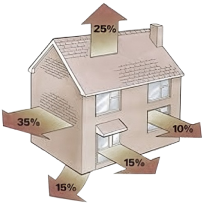Thermal insulation in one day and without building works
Save on your bills with Smart Thermal Insulation. Minimise the amount of heat and cold you waste and improve the comfort of your home
Calculate your insulation rating

What is blown thermal insulation?
Blown thermal insulation is the cheapest and most effective solution for saving energy. Approximately 30-35% of heat loss or cold input in a house is produced by the walls, but thanks to this technique your home will gain in efficiency and comfort forever, since it does not need maintenance.
How is it installed?



Without building works
Blown thermal insulation is a very simple intervention. It can be carried out through the outside of the façade, or on the inside (without the need for scaffolding). It does not require planning permission.
Air chamber
This is the gap that separates the inside brick wall from the outside wall. If your house was built between 1960 and 2006, it is most likely to have a cavity.
Speed
A flat can be insulated in one day. The insulating material is injected through small holes in the wall, filling the cavity. It provides homogeneous insulation while preventing draughts - and it also insulates acoustically!
Advantages of thermal insulation with Iberdrola
Heat and cold escape from your home without you realising it, take the plunge and turn your house into an efficient home.
Savings on your bill
Consume less energy and reduce your gas or electricity bill by up to 30%.
Peace of mind
Installation without building works in one day. No maintenance, no associated costs.
Comfort
More comfort at home, both in winter and summer. Reduces noise from outside.
Easy payments
You can finance the installation of insulation according to your needs.
Thermal insulation calculator
1/4 Type of home
Next: Size of home
1. Select home type
Flat
Terraced house
Semi-detached house
Detached house
2/4 Size of home
Siguiente: Wall cavity size and finishes:
2. Select the size of your home
Choose the area that is closest to its actual size.
Up to70m²
Up to100m²
Up to130m²
2/4 Size of home
Siguiente: Wall cavity size and finishes:
2. Select the size of your home
Choose home type that best suits the characteristics of your home.
Up to120m²
Up to150m²
Up to180m²
2/4 Size of home
Siguiente: Wall cavity size and finishes:
2. Select the size of your home
Choose home type that best suits the characteristics of your home.
Up to120m²
Up to150m²
Up to180m²
2/4 Size of home
Siguiente: Wall cavity size and finishes:
2. Select the size of your home
Choose home type that best suits the characteristics of your home.
Up to150m²
Up to200m²
Up to250m²
3/4 Wall cavity size and finishes:
Next: Summary and personal details
3. Does your house have an air chamber?
3/4 Wall cavity size and finishes:
Next: Summary and personal details
3. Does your house have an air chamber?
3/4 Wall cavity size and finishes:
Next: Summary and personal details
3. Does your house have an air chamber?
3/4 Wall cavity size and finishes:
Next: Summary and personal details
3. Does your house have an air chamber?
3/4 Wall cavity size and finishes:
Next: Summary and personal details
3. Does your house have an air chamber?
3/4 Wall cavity size and finishes:
Next: Summary and personal details
3. Does your house have an air chamber?
3/4 Wall cavity size and finishes:
Next: Summary and personal details
3. Does your house have an air chamber?
3/4 Wall cavity size and finishes:
Next: Summary and personal details
3. Does your house have an air chamber?
3/4 Wall cavity size and finishes:
Next: Summary and personal details
3. Does your house have an air chamber?
3/4 Wall cavity size and finishes:
Next: Summary and personal details
3. Does your house have an air chamber?
3/4 Wall cavity size and finishes:
Next: Summary and personal details
3. Does your house have an air chamber?
3/4 Wall cavity size and finishes:
Next: Summary and personal details
3. Does your house have an air chamber?
4/4 Summary and personal details
4. Your recommended thermal insulation
One of our qualified technicians will visit your home to provide you with a custom quote
(1) The reduced VAT rate of 10% applies to natural persons in private homes (not for professional or business purposes) and residents' associations
4/4 Summary and personal details
4. We have other solutions for you
Blown-in thermal insulation requires an air gap, but thanks to our Smart solutions you can also achieve an efficient home and save on your bill. Find out which one is best for you:

Smart Home
Control your home from your mobile, control heating, turn lights on and off.

Smart Clima
Turn on and off and control temperature in your home, wherever you are. It?s much easier now.
Back
Back
Next
Calculate again
We have received your request and we will call you right away.
Thanks
€/month incl. VAT in 12 interest-free payments
Estimated price for
m linear meters of exterior façade insultarion, height of 2.5m and 20% of wall cavities. Volume of wall cavity to be filled approximately
m3.Estimated reduction of heating and cooling consumption of 15% for homes constructed before 1980, and of 10% for homes constructed between 1980 y 2006
m3.Estimated reduction of heating and cooling consumption of 20% for homes constructed before 1980, and of 15% for homes constructed between 1980 y 2006
Do you want to benefit from Energy Savings Certificates?
Join the change, at Iberdrola we help you to be more efficient with your energy and maximise your savings.
Any questions?
Here are some of the most frequently asked questions
Aislamiento térmico
Thermal insulation is the main, cheapest and most effective energy-saving measure. What's more, most thermal insulation provides effective sound insulation, keeping bothersome noise out of the building.
There are numerous simple ways of insulating the home which can significantly reduce the amount of heat wasted and keeping gas and electricity bills lower (for heating and air conditioning).
Any renovations and modernisation carried out on the home are a superb occasion for analysing energy efficiency and insulation: you'll gain in comfort, lower your bills and emissions and add to the value of your home.
Spain has set itself an objective within the National Integrated Energy and Climate Plan (PNIEC) to upgrade 1.2 million homes by 2030.
Although there is no "one-size-fits-all" solution, generally speaking, houses lose warmth as follows:
- from 30 % to 35 % through walls and thermal bridges
- Around 25 % through the roof and terraces
- up to 25 % through doors, windows, seals, and cracks
- Between 7 % and 15 % through the floor, depending the type of home

- From the outside, it's the most efficient way to reduce energy demand, with the External Thermal Insulation Composite System (ETICS) or ventilated façade. The drawback is that the project must tackle the entire building, it can take several weeks, and it is the most expensive solution.
- Insulation can be installed on the inside (lining), with multiple solutions existing on the market. The drawback is that it reduces the amount of living space in the home and does not deal with thermal bridges.
- In the middle: a very quick, economical and effective technique is insulation injecting insulating material into the air chambers of walls and roofs, provided that the dwelling has double partition walls (double-leaf façades, façades with air chambers) or a false ceiling. The drawback is that it can only be used if there is an air chamber. Like the facing shell method, it does not resolve the thermal bridge issue.
The heating/cooling system will start up less frequently, and I will notice fewer temperature variations. This will mean lower heating/cooling bills.
Improved insulation helps to prevent draughts, moisture and mould, improving living conditions and health.
Blown thermal insulation
The insulating material is blown into the air cavity, filling the entire cavity and providing homogeneous insulation while stopping draughts. And it also provides sound insulation!
If your home was built after 1960 and before 2006, it most likely has air cavities. If it was built after 1979, it probably has some insulation, although it is probably insufficient.
If the wall sounds hollow when you bang on it, or if when you go close to the socket (without touching it) you notice air currents, then you have air cavities.
In any case, an Iberdrola partner can come to your home to see if there is an air cavity and measure its thickness to provide you with an estimate for blown cavity wall insulation.
The operation can be carried out from the inside or the outside, provided that there is a common electricity supply for the blower. In the case of tiled rooms, it is preferable to insulate from the outside to avoid perforating the tiles.
There is no requirement for a building permit and additional equipment is only needed in the case of high buildings. In such cases, if the building residents' association agrees, the cost of additional measures is offset with the economy of scale of making the improvement jointly.
Different materials are used in blown cavity wall insulation, but they all have properties or treatments that mean they require no maintenance. Thermal insulation will reduce the demand for energy in the home, which will put a smile on your face when you see your fuel bills are lower, year after year. The planet will thank you, too. What's more, it will improve your quality of life and provide sound insulation.
| Glass mineral wool |
Polyurethane | Rock wool | Cellulose | EPS |
|---|---|---|---|---|
| Thermal properties | ||||
Excellent (Conductivity 0,034w/m2k)
|
Excellent (Conductivity 0,034w/m2k)
|
Good (Conductivity 0,038w/m2k)
|
Good (Conductivity 0,040w/m2k)
|
Excellent (Conductivity 0,035w/m2k)
|
| Fire resistance | ||||
Flame-resistant (Euroclass A1)
|
Inflammable (Euroclass E)
|
Flame-resistant (Euroclass A1)
|
Fire resistant (Euroclass B2)
|
Fire resistant (Euroclass B2)
|
| Water absorption | ||||
Waster resistant
|
Waster resistant
|
Waster resistant
|
Does not resist water
|
Waster resistant
|
| Durability | ||||
Long-lasting (Settlement S1)
|
Losses quality
|
Long-lasting (Settlement S1)
|
Losses quality(Settlement S3)
|
Long-lasting (Settlement S1)
|
| Drilling | ||||
Nozzle (From 16)
|
Nozzle (From 16)
|
Nozzle (Usually 38)
|
Nozzle (Usually 38)
|
Nozzle (From 16)
|
| Sound insulation | ||||
Good isolation
|
Does not isolate
|
Good isolation
|
Good isolation
|
Does not isolate
|
| Thermal properties | |
|---|---|
| Glass mineral wool | Excellent (Conductivity 0,034w/m2k)
|
| Polyurethane | Excellent (Conductivity 0,034w/m2k)
|
| Rock wool | Good (Conductivity 0,038w/m2k)
|
| Cellulose | Good (Conductivity 0,040w/m2k)
|
| EPS | Excellent (Conductivity 0,035w/m2k)
|
| Fire resistance | |
|---|---|
| Glass mineral wool | Flame-resistant (Euroclass A1)
|
| Polyurethane | Inflammable (Euroclass E)
|
| Rock wool | Flame-resistant (Euroclass A1)
|
| Cellulose | Fire resistant (Euroclass B2)
|
| EPS | Fire resistant (Euroclass B2)
|
| Water absorption | |
|---|---|
| Glass mineral wool | Waster resistant
|
| Polyurethane | Waster resistant
|
| Rock wool | Waster resistant
|
| Cellulose | Waster resistant
|
| EPS | Waster resistant
|
| Durability | |
|---|---|
| Glass mineral wool | Long-lasting (Settlement S1)
|
| Polyurethane | Losses quality
|
| Rock wool | Long-lasting (Settlement S1)
|
| Cellulose | Losses quality(Settlement S3)
|
| EPS | Long-lasting (Settlement S1)
|
| Drilling | |
|---|---|
| Glass mineral wool | Nozzle (From 16)
|
| Polyurethane | Nozzle (From 16)
|
| Rock wool | Nozzle (Usually 38)
|
| Cellulose | Nozzle (Usually 38)
|
| EPS | Nozzle (From 16)
|
| Sound insulation | |
|---|---|
| Glass mineral wool | Good isolation
|
| Polyurethane | Does not isolate
|
| Rock wool | Good isolation
|
| Cellulose | Good isolation
|
| EPS | Does not isolate
|
Price and savings
It costs between around €800 and €1500 to insulate a flat. A detached home from €1200 to €2,500 or even more in the case of a large property.
The thicker the chamber, the more insulating material is needed to fill it and the greater your savings on heating and air conditioning.
It's the ideal solution if you have air chambers and gives you the best return on each euro invested in insulation.
All our estimates are made to measure and after a technician's visit, since it is impossible to assess from a distance and even more so taking into account the enormous variability inherent in architecture.
The surface area of the house to be insulated tells me how “big” the shelter to be placed will be, and the size of the cavity how “thick” that shelter will be.
The more you spend on heating your home, the bigger the potential savings and reduction of emissions.
If you also decide to upgrade your heating system, you can choose something less powerful, which will be kinder to the environment and make more savings.
Customised
The larger the space above the false ceiling, the greater potential for gains there will be. We will also have to use more material to fill it, but the additional improvement will be worth the increased cost.
If the false ceiling is inclined (attic areas) it is necessary to fill it completely regardless of the space since it is the only way to guarantee that the placement of the material is correct.
If we have given you a quote for the façade and roof and you are not sure to what extent you wish to contract, the technician will advise you, but the general recommendation will be that we start the insulation with the roof (false ceiling or roof as the case may be).
The house may not start with the roof, but at Aislamiento Smart we do start improving efficiency from the top!
Articles you may find interesting
-
Energy savings
7 November 2022
6 min reading
What is thermal bridging and how does it affect air tightness?
Bubbles or "blisters" on the wall? A colony of black spots spreading through the house?...
Read more > -
Energy savings
10 August 2022
6 min reading
Smart Assistant, the app that allows you to control your home's...
Digital transformation has accelerated in the last year. We have confirmed that we can...
Read more > -
Energy savings
10 August 2022
6 min reading
Eight infallible tricks to save on the new electricity bill
In addition to concentrating consumption in the cheapest hours, it is useful to know some...
Read more >
Do you have any more questions?
We'll answer all your questions via any of our channels.
We call you
We have received your application and we will call you right away. Many thanks.